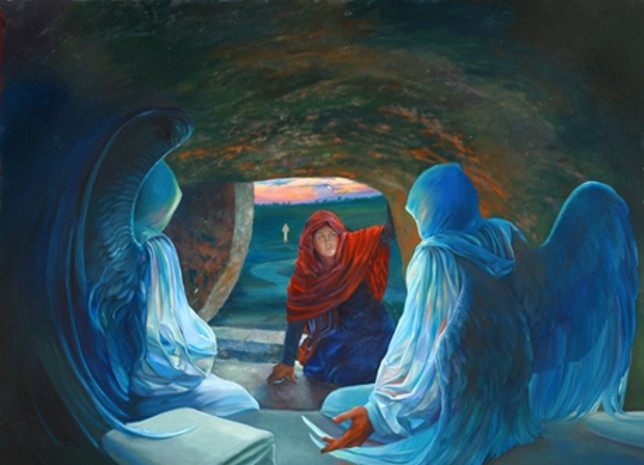by Bob Nyberg
When Mary Magdalene discovered the empty tomb, did she witness the antitype of the Ark of the Covenant?
Baker's Dictionary of Theology says, "A type is a shadow cast on the pages of OT history by a truth whose full embodiment or antitype is found in the NT revelation."1
GotQuestions.org says: "We can define a type as a 'prophetic symbol' because all types are representations of something yet future. More specifically, a type in Scripture is a person or thing in the Old Testament which foreshadows a person or thing in the New Testament."2
Spurgeon wrote, "Let us think of what was in the ancient ark of the covenant, for all that was in that ark as a type is to be seen in Christ our heavenly covenant ark above."3
Dr. David Reagan says: "Jesus fulfilled every prophetic type of the Ark."4
With that background, let's compare the scene at the empty tomb, with the description of the Ark of the Covenant in the Old Testament.
John 20:11-12: But Mary was standing outside the tomb weeping; and so, as she wept, she stooped and looked into the tomb; and she saw two angels in white sitting, one at the head and one at the feet, where the body of Jesus had been lying.Exodus 25:17-22: You shall make a mercy seat of pure gold, two and a half cubits long and one and a half cubits wide. You shall make two cherubim of gold, make them of hammered work at the two ends of the mercy seat. Make one cherub at one end and one cherub at the other end; you shall make the cherubim of one piece with the mercy seat at its two ends. The cherubim shall have their wings spread upward, covering the mercy seat with their wings and facing one another; the faces of the cherubim are to be turned toward the mercy seat. You shall put the mercy seat on top of the ark, and in the ark you shall put the testimony which I will give to you. There I will meet with you; and from above the mercy seat, from between the two cherubim which are upon the ark of the testimony, I will speak to you about all that I will give you in commandment for the sons of Israel.
Leviticus 16:14: Moreover, he shall take some of the blood of the bull and sprinkle it with his finger on the mercy seat on the east side; also in front of the mercy seat he shall sprinkle some of the blood with his finger seven times.
Hebrews 9:5 tells us, "And above it [the Ark of the Covenant] were the cherubim of glory overshadowing the mercy seat; but of these things we cannot now speak in detail." The word translated "mercy seat" in this verse is hilastōrion. This word is also found in Romans 3:25, where it is translated "propitiation." Paul says:

"Being justified as a gift by His grace through the redemption which is in Christ Jesus; whom God displayed publicly as a propitiation [hilastōrion] in His blood through faith. This was to demonstrate His righteousness, because in the forbearance of God He passed over the sins previously committed (Romans 3:24-25)."
Paul portrays Jesus Christ as the hilastōrion or "mercy seat."
Young's Literal Translation renders Paul's words like this:
"Being declared righteous freely by His grace through the redemption that is in Christ Jesus, whom God did set forth a mercy seat [hilastōrion], through the faith in his blood, for the shewing forth of His righteousness, because of the passing over of the bygone sins in the forbearance of God (Romans 3:24-25)."
The mercy seat was a picture or type of Jesus Christ and His sacrifice on the cross. Jesus was the realization or antitype of the Old Testament mercy seat.
It could very well be that what Mary saw at the empty tomb that day was evidence of this Old Testament picture of propitiation. She saw the two angels, one at either end of where Jesus' body was laid. The angels in the tomb seem to correspond to the cherubim on either end mercy seat.
Someone might object saying that when Mary saw these angels, Jesus' body was gone because He had been raised from the dead. In other words, although the angels were there in the tomb when Mary looked in, the mercy seat (represented by Jesus' body) was gone. Hebrews tells us:
By this will we have been sanctified through the offering of the body of Jesus Christ once for all. Every priest stands daily ministering and offering time after time the same sacrifices, which can never take away sins; but He, having offered one sacrifice for sins for all time, SAT DOWN AT THE RIGHT HAND OF GOD, waiting from that time onward UNTIL HIS ENEMIES BE MADE A FOOTSTOOL FOR HIS FEET. For by one offering He has perfected for all time those who are sanctified (Hebrews 10:10-14).
Since the sacrifice had been completed at the cross, Jesus sat down at the right hand of God. The earthly mercy seat in the Old Testament was needed for continual sacrifices unlike the perfect, final sacrifice of Jesus. Jesus was offered once and then He was raised for our justification (Romans 4:25). When Jesus died on the cross, He said "it is finished!" The hilastōrion-propitiation for sins-was complete. The objective of the mercy seat had been accomplished. Now Jesus sits at the right hand of God the Father as our throne of grace, so that we may receive mercy and find grace to help in time of need (Heb. 4:16).
1 Cairns, Alan. Dictionary of Theological Terms 2002, p. 497.2 http://www.gotquestions.org/typology-Biblical.html
3 http://biblehub.com/library/spurgeon/spurgeons_sermons_volume_41_1895/the_ark_of_his_covenant.htm
4 http://www.lamblion.us/2008/08/ark-of-covenant-as-prophetic-type.html
